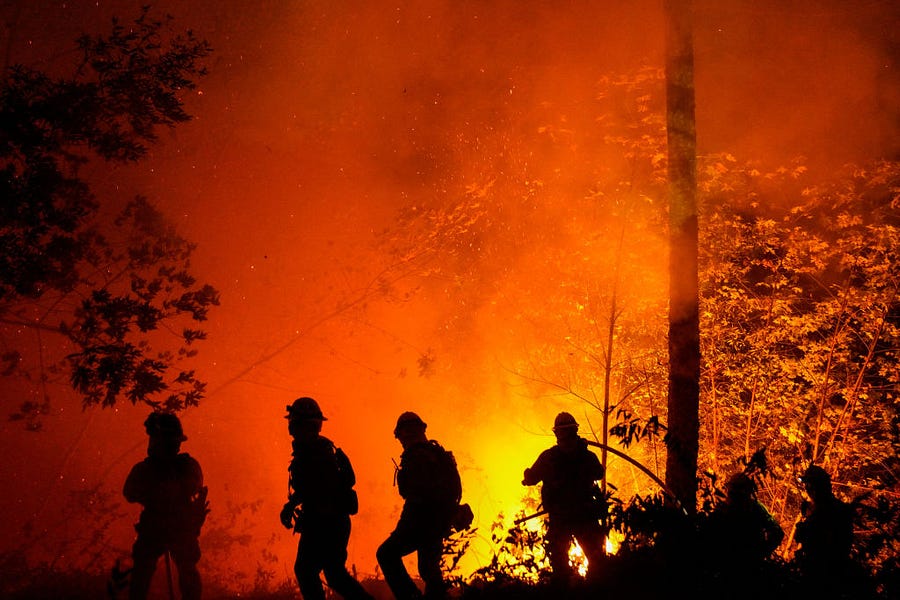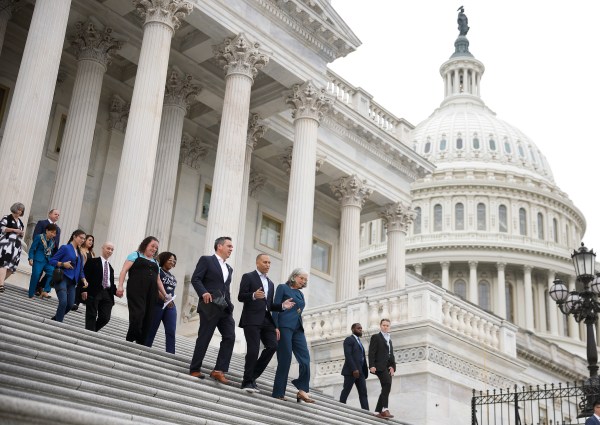The Western wildfires that dominated headlines in August and September continue to burn, and there are several months left in this year’s “fire season.” The August Fire in Northern California became the second-largest fire in the state’s history last month, and the Glass Fire is burning through large portions of Napa and Sonoma counties. Tens of thousands of people have been forced to evacuate and air quality in many parts of California remains unhealthy.
The Dispatch sat down with Arkansas Rep. Bruce Westerman, graduate of Yale Forestry School and the only registered forester in Congress, to discuss his work promoting better forest management in the federal government and the costs of allowing each year’s fire season to get worse.
So what fire prevention legislation have you been working on?
Well, the latest thing I’ve got out is the Trillion Trees Act, which addresses planting trees, how to make our existing forests healthier, and how do we do sustainable buildings, which are closely tied to [the health of] our forests and the climate. How do we prevent catastrophic wildfires? How do we make our forest healthier? And how do we maximize the amount of carbon that these forests are storing?
So the more trees we’ve got that are sitting out there full of carbon, the better we are at cleaning the atmosphere. When we see fires like you’re talking about out there now [in California], that is spewing carbon into the atmosphere. And it’s not only spewing carbon into the atmosphere, it killed those trees that were spewing carbon out.
This is just a back-of-the-napkin calculation; if they end up burning 10 million acres in California, that needs to be replanted. And so you use 400 trees per acre, you’re talking about 4 billion trees that would need to be replanted on the land. So how much farther does that put us back than if we had managed the forests and been able to put the fires out, or let the fires run through the forest and not kill all the trees?
So what’s the current state, then, of forest management with the U.S. Forest Service and federal land?
So that’s an interesting question that I’ve been doing research on. I’ve gone back and read about when the Forest Service was established, the first American Forest Conference, the proceedings where Teddy Roosevelt gave the opening remarks and Gifford Pinchot, stating accounts of the birth of forestry, of forestry management, in our country. The Forest Service was created so that you could have professionals applying science-based practices to public land.
And they’ve got a long distinguished history. But what’s happened over time is that we’ve put good environmental laws in place, like the Clean Water Act, the Clean Air Act, NEPA [National Environmental Policy Act]—which had really good intentions. And we’ve created mechanisms for people to sue these land managers to stop them from doing their jobs. The thing impeding the health of our forests, more than anything else, is the handcuffs that are on these agencies that want to apply scientifically based management. It’s not going to work itself out under our current process. Laws that were meant for good are being weaponized and causing harm. The Forest Service will get sued because of the Clean Air Act, the Clean Water Act, or more often NEPA. Everything comes to a grinding halt. When you’re talking about forests, which are dynamic living organisms, no action is an action—fuel builds up.
The one thing that hasn’t stopped is the Forest Service putting out fires, and the cost of that is going through the roof. We spend all this money fighting fires; we should be spending money doing management so that the fires aren’t as intense. We’ve got to figure out how to get everybody who has these competing interests in the forest to realize that for everybody’s benefit, we need to apply scientific practices and let the forest service do their job.
Envision this: We do the management, you don’t have heavy fuels on the forest floor, lightning strikes, and fire burns across the forest floor. It’s not like we’re inventing something new. It’s just applying the knowledge we have to take care of this problem and solve it.
Exactly. And very not new, right? Yosemite looks the way it does because Native Americans were burning it for hundreds of years.
Actually Yosemite is a good case study. If you study the portraits that Ansel Adams took, Yosemite does not look like when John Muir went there because the Native Americans actually did manage Yosemite. There were glades and clearings in Yosemite because they used fires at regular intervals. One of the pictures Ansel Adams took of El Capitan at one time, if you stood in the same place that Ansel Adams stood to take the picture, you couldn’t see El Capitan because the trees had grown up so much.
People have this idea that nature’s just this pristine, balanced, tranquil, place. And it’s not, it’s really a vicious cycle: the tree grows, they fill up the space, they compete with each other, you get insects and disease that come in, you get dead and dying trees, you get a lightning strike and winds, and nature tries to reach that balance with fire. And it just goes back and forth. But through forest management, we know how to go in and mimic certain acts of nature to keep it in more of a balanced state. And that's what the Native Americans did before we got here.
So let’s say that you and the federal government succeed at taking some of the constraints off of forest management under, say, NEPA—what’s the scale of the task we’re looking at? Because we haven’t been doing significant controlled burns at scale in many places for decades.
Well, harvest and burning. I would say, even back to the ‘70s, we’re looking at 40 to 50 years of mismanagement. If the Forest Service was turned loose with unlimited resources, it’s gonna take years before we can get these forests back into a more healthy, resilient state. And on top of that, you have the effects of warming temperatures and less rainfall in some areas. Nature’s a complicated thing. You get more rainfall in the spring and a bigger flush of vegetative growth, you can have bigger wildfires in the fall.
But we can still be proactive. We shouldn’t be sitting back waiting for the, “Oh, it’s August. The fires are going to get bigger. Now let’s bring in more 747s and thousands of more people to fight these fires, and let's spend billions of dollars to try to put them out and we'll deal with the fallout.” Why don't we just do a little bit of preventative maintenance?
What are some immediate reforms that forest and fire services, state and federal, can make to reduce fire risks and build healthier forests? How about in the longer term?
There are four main areas where forest management is most essential right now: Wildland Urban Interfaces [WUIs], transmission corridors, transportation corridors, and critical watersheds. WUIs are the areas where residential communities meet rural land, and as more and more Americans move closer to forests, we’ve got to keep those managed properly so they’re not endangering homes and property, along with taking practical measures to make the structures more resilient to fire. Transmission and transportation corridors are also high-risk areas—the 2018 Camp Fire ignited from a stray spark off of a transformer. Something as simple as a truck dragging a chain along the road or a train wheel on a rail can create sparks and set entire forests ablaze if those transportation corridors aren’t regularly maintained.
Long term, Congress needs to reduce the bureaucratic red tape that allows litigious environmental groups to prevent forest managers from doing their jobs. We are loving our trees to death. The healthiest forests are ones that undergo regular management to clear brush and dead trees, all of which makes residual trees more resilient to pests and fires. Fire-damaged forests take years to regrow, and sometimes never return to their original state. Instead of letting the USFS and local forest services manage their resources as needed, we’re just letting them go up in flames year after year. We should be ashamed of ourselves.
Speaking of the longer term, how much do you think this is a problem to be mitigated rather than solved?
Years of congressional inaction have definitely made the problem worse. At first, I think we should focus on mitigation, doing forest management in the main areas I listed above and using that to triage where the fires are the worst (California being the obvious No. 1 here). This isn’t an issue that’s going to go away overnight. Yet after we’ve implemented sound practices that are causing fire severity to decrease each year, I think we can actually solve the problem. That doesn’t mean fires never occur; it just means that when they ignite, the forests are managed such that the fire stays close to the ground where firefighters can quickly extinguish it, rather than spreading up into the tree canopy and igniting the entire forest. We saw a clear example of this during the 2018 Camp Fire, where aerial footage shows the fire spreading rapidly across unmanaged public land, and then abruptly stopping when it hit a planned fire break on private land. This happened because the land managers had aggressively cleared the forest, causing the fire to drop to the ground and run out of fuel. We should be applying this science all across the West.
So how do you do timber harvesting in a sustainable way that really manages the forest? I know that in the early 20th century, we had some massive wildfires out West and a lot of those were actually caused by logging, by strip logging and poor management techniques on the part of the corporations.
We were horrible. Our country was horrible when Europeans first came here, our management was not a good thing. It’s not a pretty spot in our history. They looked at the forest as an obstacle, they wanted to clear land to have places to plant crops. And a lot of that was, they just didn’t understand it.
So that drove Roosevelt to start this conservation movement. You know I tell my Republican colleagues that the word conservation comes from conservative. It’s someone that feels they’ve got an unchosen obligation to the past and to the future.
So our forests were in a horrible shape and they weren’t doing management, they were cutting out and getting out. That was the term for it, you cut until it's all gone and you move somewhere else because at the time they thought there was an endless sea of timber. It’s the tragedy of the commons on the size and scale of our country, basically. So they went from the East Coast to the West Coast and pretty much everywhere in between.
And on federal land we don’t have to clear cut. We can tend from below and use controlled burns on a set interval to keep these forests healthy. And over time they’ll get back to that structure and age distribution that the Native Americans saw, but on the current trajectory, what they’re going to do is that maybe every 50 years, maybe every 100 years, they're going to burn to the ground, and they're going to start over and it's just going to be a violent repeating cycle.
Photograph by the Los Angeles Times.







Please note that we at The Dispatch hold ourselves, our work, and our commenters to a higher standard than other places on the internet. We welcome comments that foster genuine debate or discussion—including comments critical of us or our work—but responses that include ad hominem attacks on fellow Dispatch members or are intended to stoke fear and anger may be moderated.
With your membership, you only have the ability to comment on The Morning Dispatch articles. Consider upgrading to join the conversation everywhere.